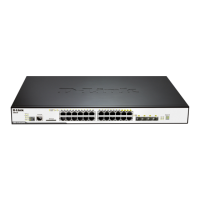xStack
®
DGS-3120 Series Layer 3 Managed Gigabit Ethernet Switch CLI Reference Guide
705
<key_id 1-255>] | metric <value 1-65535> | state [enable | disable] | passive [enable | disable]
| distribute_list_in [access_list <list_name 16> | none]}(1)
Parameters
ipif - Specify the name of the IP interface.
<ipif_name 12> - Enter the IP interface name here. This name can be up to 12 characters
long.
all - Specify that all the IP interfaces will be used.
area - (Optional) Specify the area to which the interface is assigned. An Area ID is a 32-bit
number in the form of an IP address (xxx.xxx.xxx.xxx) that uniquely identifies the OSPF area
in the OSPF domain.
<area_id> - Enter the area ID used here.
priority - (Optional) Specify the priority value for the Designated Router election. If a Router
Priority of 0 is set, the Switch cannot be elected as the DR for the network.
<value> - Enter the priority value used here.
hello_interval - (Optional) Allows the specification of the interval between the transmission of
OSPF Hello packets, in seconds. Between 1 and 65535 seconds can be specified. The Hello
Interval, Dead Interval, Authorization Type, and Authorization Key should be the same for all
routers on the same network.
<sec 1-65535> - Enter the hello packet interval value here. This value must be between 1 and
dead_interval - (Optional) Allows the specification of the length of time between the receipt of
Hello packets from a neighbor router before the selected area declares that router down. An
interval between 1 and 65535 seconds can be specified. The Dead Interval must be evenly
divisable by the Hello Interval.
<sec 1-65535> - Enter the dead interval value here. This value must be between 1 and 65535
authentication - (Optional) Specify that authentication value.
none - Specify that the authentication value will be set to none.
simple - Specify that a simple text password must be specified.
<password 8> - Enter the simple text password value here.
md5 - Specify that the authentication will be set to use an MD5 key ID.
<key_id 1-255> - Enter the MD5 key used here. This key can must be between 1 and 255.
metric - (Optional) Specify the interface metric used.
<value 1-65535> - Enter the metric value here. This value must be between 1 and 65535.
state - (Optional) Specify the OSPF interface state here.
enable - Specify that the state will be set to enabled.
disable - Specify that the state will be set to disabled.
passive - (Optional) Specify whether the designated entry should be a passive interface or not.
When the interface is specified to be passive, OSPF protocol packets will neither be sent out
or received on the interface.
enable - Specify that the passive interface will be enabled.
disable - Specify that the passive interface will be disabled.
distribute_list_in - Specify the inbound route filter on the OSPF interface.
access_list - Use an IP standard access list to filter the receiving OSPF routes.
<list_name16> - Enter the access list name.
none - Specify not to filter the receiving OSPF routes.
Restrictions
Only Administrator, Operator and Power-User level users can issue this command.
Example
To configure OSPF interface settings:

